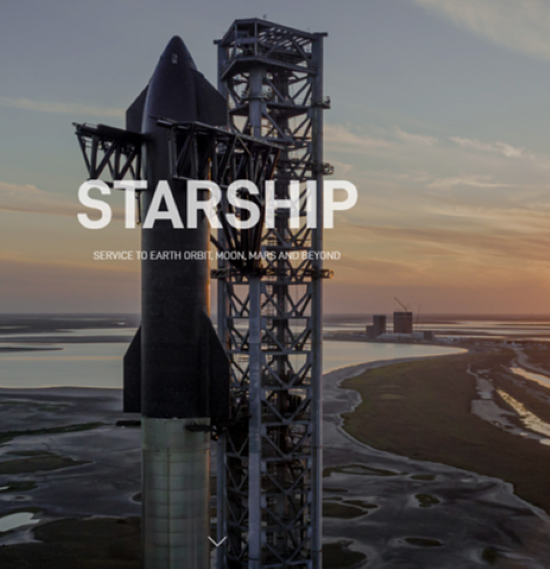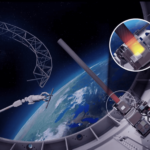Lucky October 13th has brought good news from the fifth test flight of the Starship and its super heavy booster. Yesterday morning’s launch and tower recovery of the super heavy booster using the chopsticks to catch it during final descent was an impressive feat of engineering. Meanwhile, Starship flew in space for 58 minutes before making a spot-on controlled landing in the Indian Ocean.
Starship stands 122 metres (over 400 feet) in height when stacked atop the super heavy booster. It is the largest rocket ever built, even bigger than NASA’s Space Launch System (SLS) that the Agency intends to use to send astronauts back to the Moon. A version of Starship, the Human Landing System (HLS), is essential to NASA’s plans for the Artemis 4 flight that tentatively will launch sometime in 2026.
NASA considers these Starship test flights critical. SpaceX refers to the Starship upper stage as the Ship. For NASA it needs to demonstrate reusability and reliability not for Earth landings but for ferrying the astronauts from lunar orbit to the surface and back. It has to withstand near-vacuum conditions in space and repeat controlled landings and takeoffs from the lunar surface.
Today, the Ship flew its 58 minutes in low-Earth orbit and made a controlled re-entry to hit its intended target in the Indian Ocean. The heat shield held. The navigation control fins did their job through the hot plasma descent. The SpaceX Starlink satellite network broadcast live video throughout providing views we have never seen before whether produced by NASA or any other space agency. Camera-equipped buoys captured the landing on the Indian Ocean surface. The only flaw in the performance was the Ship exploding after landing. The explosion likely happened because of the combination of residual fuel on board the Ship, its still-hot surface and contact with seawater. There were no plans to recover the Ship for this test flight but what caused the fireball we all witnessed on camera is important for addressing reusability and durability.
If the Starship succeeds in meeting all its milestones, it will make all existing launch systems obsolete. Reusability and durability will be among its key differentiators. Payload capacity will be another. No longer will Low-Earth orbit (LEO) space be the preserve of government agencies.
NASA is playing a significant role in pushing the reusability agenda. It wants to become a tenant in LEO space with commercial operators building space stations it can use for ongoing research. The Ship can also drive down the cost of building LEO infrastructure.
Getting to LEO is very expensive today. The cost for the International Space Station (ISS) build totals $150 billion US. Transporting crews to and from it comes in at variable costs. On SpaceX’s Dragon capsules, each mission costs $287 million or $72 million per seat. Using Soyuz to get to and from the ISS comes in at a per-seat cost of $86 million. If Starliner becomes certified, its seat price will be $90 million.
Payload costs per kilogram today vary from a low of $1,500 on a SpaceX Falcon Heavy to a high of $19,000 on China’s Long March rocket. Russia’s Soyuz-2 rocket payload costs per kilogram run between $5,300 and $9,700. When the US Space Shuttle was first conceived the estimated cost to deliver payload was supposed to come in at $260 per kilogram. As costs spiralled the end price came in at $14,200, almost 55 times greater.
SpaceX has demonstrated partial reusability with its Falcon Heavy and Falcon 9 launches. The first stage of the Falcon 9 and non-core stages of the Falcon Heavy are reusable with some having flown more than 20 times. Today, Falcon 9 can deliver payloads to LEO for $2,720 per kilogram. With full reusability, the Ship may be able to bring costs down to under $1,000.
That $1,000 figure is still too much when you consider the mass of the ISS today at more than 362,000 kilograms. After 2030 when ISS is de-orbited, commercial space stations that replace it will be smaller. NASA is looking to use these commercial replacements for payload deliveries of up to 5,000 kilograms per launch and 2,000 kilograms per return flight.
At $1,000 the price per kilogram to build space infrastructure will remain uneconomical. SpaceX, however, has plans to drop the cost to orbit using the Ship not just for LEO flight, but also for making point-to-point suborbital deliveries on Earth. It aspires to reduce payload costs per kilogram on suborbital flights to $2.50 and on LEO flights with a reusability rate of 100 launches and landings at prices between $13 and $30 per kilogram. If you do the math, at $13 to $30, you could deploy the equivalent of the ISS for between $4.7 and $10.9 million. Now those are numbers commercial space operators would happily live with.
So when Starship took off on its fifth test flight yesterday, that’s what was riding on its demonstration, a future commercial space industry that now is possibly one step closer to reality.








